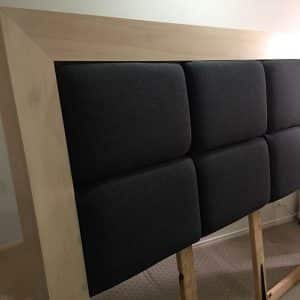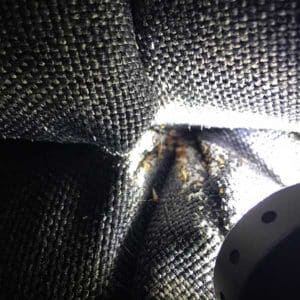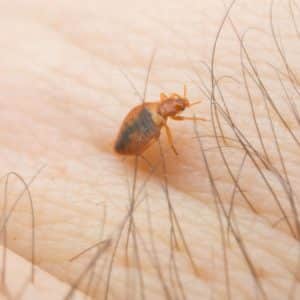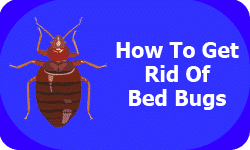Bed Bugs are a traveling pest which can be brought into the home in many ways. From buying used furniture to luggage or clothes left on hotel rooms floors.
Bed Bugs have traditionally been seen as a major problem in all kinds of dwellings from shelters, private homes, backpackers, army barracks, and even cruise ships. When you look at a bedbug up close, its color can range from burnt orange to deep brown, to a tan color or white color.

An adult bedbug will typically double its size when it is done feeding. Adults, eggs, and nymphs can be seen using a naked eye. The reason they are called bedbugs is due to their preferred environments when they are in a human home: clothing, sofas, bed mattresses, and other kinds of soft furnishings. They are also known to prefer dark surroundings.
Some have even gone as far as adapting to the human environment. Newborn bedbugs are known as nymphs, and although they tend to be tiny, they are still visible and will normally be the size of a seed. Adult bedbugs can grow up to 6mm long and will have a flat, oval shape when they have not fed for a while.
What to look for
Upon feeding, you are likely to observe a black blob or dark red color on their bodies. If you disturb them, they are likely to seek shelter in a crevice or dark crack. They are extremely agile and quick on their feet to scurry away. It is not often that people say they have felt Bed Bugs crawling on them. The reason for this is the Bed Bug stays on the material and bites the person where the skin meets the sheets. Staying dormant until you are deep asleep.
Signs of Bed Bugs

A bed bug bite is perhaps the clearest indication that your home has an infestation. When they inhabit your home, people are likely to start complaining of bites when they wake up. When this starts to happen, you need to examine all rooms for these insects and any signs of their activity.
Take a close look at mattress tufts and on the bed linen. Other areas to check will be on the box springs. During this examination, you will be checking for their eggs or bugs. Bedbug eggs resemble pale poppy seeds.
Some of the places that are likely to have evidence of bed bug activity include your drawers, beneath loose wallpapers located near beds, and in the corners of your dressers and desks. Be on the lookout for rust-colored or dark brown bedbug droppings that normally stain mattresses and bed linen.
Their excrement is liquid in nature and tends to be either black or brown in color. The excrement can be either be absorbed by the material surrounding it, or it may bead up. Your home is likely to have a coriander-like odor when it has been inhabited by a large population of these insects.
Bed Bugs Symptoms

Bedbugs will normally feed on their hosts when they are sleep. As they feed, they will be drawing blood from you in a manner that is completely painless. The feeding process leads to the introduction of their saliva into their hosts’ skin.
If the bedbugs choose to feed on one person for a few weeks, this person is likely to become sensitive to the bedbug bite, their saliva, and the chemicals that are in the saliva. This may lead to the host developing an allergic response to this bite.
As is the case with fleas, bed bugs tend to feed in rows. You are likely to notice 2-3 bites in each row. The reason for these rows could be that the bedbugs are interrupted when they are feeding, which forces them to come back after a while to continue with their feeding.
Bed Bugs
A bedbug bite can take up to two weeks for it to become visible to the naked eye, despite the fact that they appear within a few days of being bitten. Their bites are much larger compared to those of flea bites. However, they do not come with a red dot as is the case with flea bites.
Bite marks may be scattered or they can appear in clusters of three bites spread over the body. It is common for people not to realize that they have been bitten, as they do not normally show any signs. This is what makes it difficult to determine whether there is an infestation or not. However, there are people who may end up becoming nauseous or ill after being bitten.
What Causes an Infestation?
Bed bugs tend to be highly adaptable, which means that an infestation can occur in a number of ways. There are those that come into a home as runaways when you are moving in your bedding, furniture, and luggage. It is recommended that you exercise care when purchasing used furniture as they may be lying in wait. If possible, desist from purchasing second-hand mattresses.
You should note that bed bugs can also be present in empty, and seemingly clean residences. The insects can go for as long as twelve months without feeding. It is possible that these insects can be able to move from one room through holes.
How to Treat a Bed bugs Bite
The treatment of a bedbug bite primarily focuses on relieving its symptoms. It can include:
•Antihistamines—assists in relieving an allergic reaction
•Topical creams—used to relieve itching
•Corticosteroids—used when a person experiences a severe allergic reaction
•Oral antibiotics—used when infection arises due to a skin infection
How to Remove Bed Bugs
In fact, bed bugs hide in many different places, it becomes a bit hard for DIY Treatments. It is, therefore, recommended that you call a pest control professional.
Bed Bugs Treatments are a managed approach that requires action from both the Pest Controller and the customer. When Bed Bugs have been identified as the biting insect. We then do a targeted treatment of low toxic chemicals and hot steam treatment. This is safe for both families and pets. The Pest Controller will give directions to the customer to remove clothes from cupboards and material/cloth furnishing from the affected room and treat as directed.
To treat Bed Bugs effectively give our helpful team a call on 1300007133 to arrange a fast appointment.

Other pest control Services
